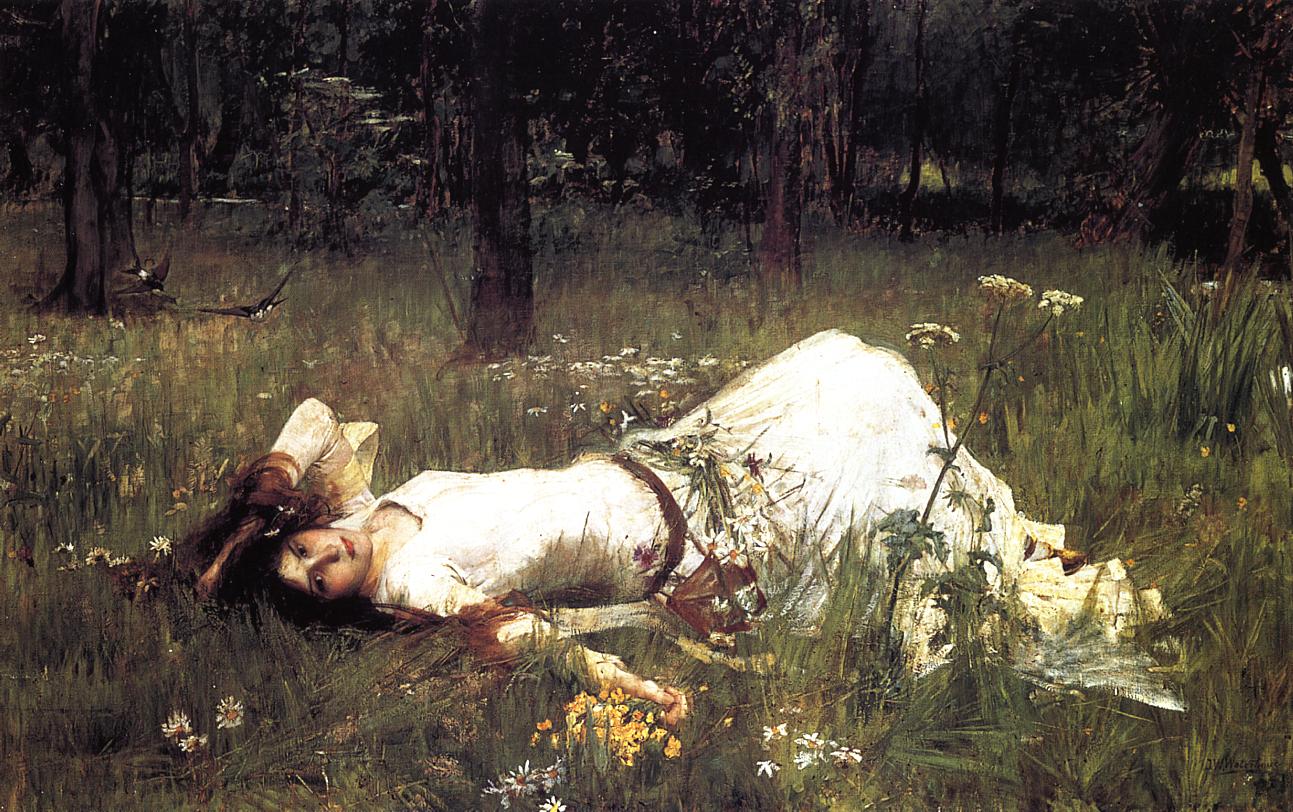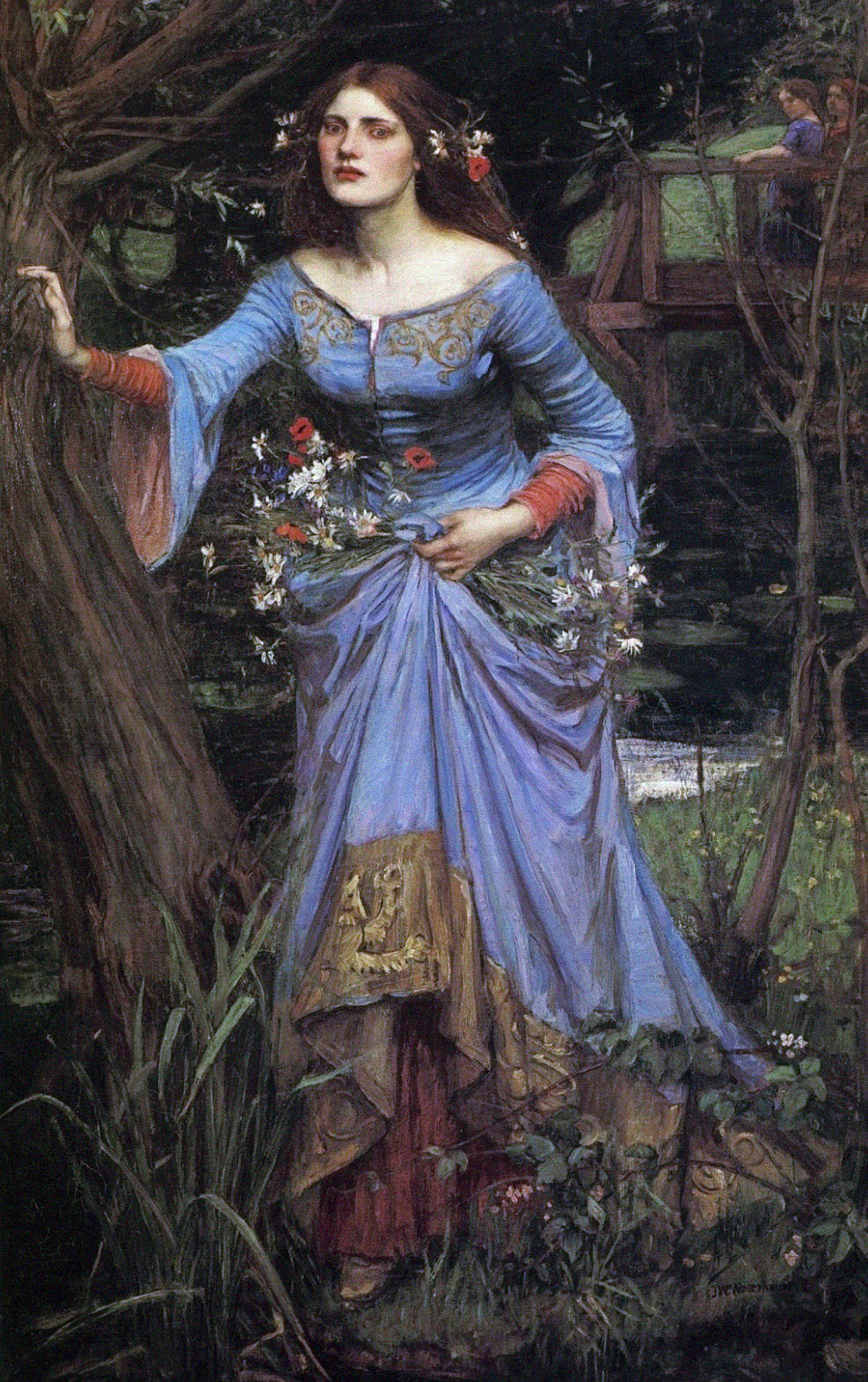Ophelia is the title given to three different paintings by the English artist John William WaterhouseEnglish artist known primarily for his depictions of women set in scenes from myth, legend or poetry. He is the best known of that group of artists who from the 1880s revived the literary themes favoured by the Pre-Raphaelites. .[1] He may have been planning to depict a fourth version of the character, as a drawing marked as A Study for ‘Ophelia in the Churchyard’ was a lot in the 1926 auction at Christie’s of his remaining works. None of his artworks bear that title; the academic Anthony Hobson suggests that the drawing may alternatively have been a study for the 1910 version.[2]
The works reflect the artist’s interpretation of the character Ophelia from the Shakespearean tragedy, Hamlet. Ophelia is the young daughter of Polonius; she is in love with Hamlet but her affection is not reciprocated. As a consequence of Hamlet murdering her father she becomes insane with grief, spending her time chanting lewd, death-obsessed, songs while gathering flowers in a riverside meadow. As she sits at the waterside twisting the flowers into garlands, she slips into the water and drowns, continuing to sing as she dies.[3]
1889 version

Oil on canvas 98 cm x 158 cm (38.5 in x 62 in)
Wikimedia Commons
The first of the Waterhouse Ophelia paintings, submitted as his Royal Academy exhibit for 1889,[4] adopted the style of the naturalistic techniques of the French artist Jules Bastien-Lepage.[5] This painting, together with The Magic CircleOil painting by John William Waterhouse, one of his earliest depictions of a classical sorceress. and The Lady of ShalottOil painting by English artist John William Waterhouse; the first in his trilogy featuring The Lady of Shalott, are the only recorded works in which he presented an imaginary figure in this style.[6]
Waterhouse depicted Ophelia lying in a wanton unladylike manner within the meadow prior to her nearing the river which is shown in the background; her dark dishevelled hair is entwined with a band of daisies. Buttercups are held in one of her hands while her dress has wildflowers she collected laid on her lap. Swallows, a motif for salvation, flit above the grass. She stares hauntingly at the viewer.[7][8][9]
According to historian Peter Trippi, she is “on the verge of sexual awakening posing provocatively among symbols of natural fecundity that will also fade.”[8] The prostrate figure is similar to that used by John Everett Millais in his 1859 painting Spring (Apple Blossoms), which Waterhouse viewed at the Grosvenor retrospective exhibition in 1886. Art expert Robert Upstone ponders that, as the figure has been reversed, the early sketches may have a degree of being traced.[10] The landscaping bears similarities to William Logsdail’s Academy exhibit of 1892, Flower Gathering in the South of France.[11][a]Waterhouse and Logsdail had been close neighbours since 1889.[12]
The painting received mixed reviews from contemporary critics. Bernard Shaw[b]After 1876 George Bernard Shaw styled himself as Bernard Shaw.[13] thought the style used worked more successfully than when Waterhouse employed it in the previous year’s exhibit, The Lady of Shalott;[8] the critic writing in The Art Journal of 1889 however declared that the artist “displays the mad maiden in no novelty of attitude”.[14] It was likely Waterhouse expected Henry Tate to purchase the work but it did not sell, staying in the artist’s possession;[15][c]Waterhouse loaned the painting to the Academy for a spell while he was working on his Diploma picture.[8] It was held by the Royal Academy from November 1895 until 1901.[16] a contemporary photograph of the painting indicates that the artist toned down the severity of Ophelia’s stare[8] also reducing the intensity of her state of madness by adjusting her mouth and eyes.[17] Ophelia was eventually sold by the artist’s widow, EstherEnglish artist, specialist in flower painting; her husband was fellow artist John William Waterhouse, in the sale at Christie’s on 23 July 1926.[18] It was acquired by Gooden and Fox for £450 guineas, reflecting the fall from favour of the work of Victorian paintersVictorian painting refers to the distinctive styles of painting in the United Kingdom during the reign of Queen Victoria (1837–1901). at that time.[4][18] Appearing at Christie’s auction on 2 August 1956, it was purchased by Dent for 16 guineas. Lord Andrew Lloyd Webber added it to his art collection in 2001.[19]
1894 version

Oil on canvas 73.6 cm × 124.4 cm (29 in × 49 in)
Wikimedia Commons
Returning more closely to his preoccupation with water and the demise of women, for his second version of Ophelia Waterhouse portrays the character in the moments before she slips to her watery death.[20] Posed sitting on the bough of a willow tree that stretches over a lily covered area of water within a darkened glade, her white opalescent, medieval-style robe is decorated with a golden royal lion. The branches of the tree form a frame around Ophelia with reeds growing in the foreground of the picture. Moving away from the intensity given to the gaze of the central figure in the 1889 version, this Ophelia has a softer appearance with only one eye shown to the viewer; the sense of her derangement and distress is given instead by her raised arms and self-absorbed expression. Her mouth is closed rather than open so she is not singing at that moment. Entwined with daisies and poppies, her long auburn hair trails down the length of her back; the poppies are a symbol of her imminent death.[21][22]
Proving to be the most popular of Waterhouse’s depictions of Ophelia, engravings of it were carried in The Magazine of Art in 1895 and repeated in The Art Journal of 1909.[22] Like the earlier version, it also received mixed reviews from contemporary critics. The reviewer in The Magazine of Art felt it was “pictorially a strong reading of character” whereas George Moore writing in The Speaker scathingly noted it as “a vulgarity of Tottenham Court Road manufacture.”[23][d]Art historian Angus Trumble states George Moore was known to dislike any paintings showing a French influence; Moore was also uncomplimentary about Waterhouse’s Circe InvidiosaPainting by John William Waterhouse completed in 1892, his second depiction of the Greek mythological character Circe. writing that “The colour scheme, the blue dress and the green water–how theatrical, how its richness reeks of the French Studio!”[23]
Exhibited at both the New Gallery and the Liverpool Autumn exhibition in 1894, it was purchased from the artist by George McCulloch for around £700.[24][25][e]George McCulloch (1848-1907), a Scottish businessman, was a multi-millionaire who made his fortune from investments and silver mining in Australia; he returned to Britain in 1893 and, over the next decade, amassed a large art collection of more than 300 pictures.[26] During the next century the painting was auctioned several times; the prices achieved chart the decline and eventual return to fashion of Victorian art.[27] Following McCulloch’s death, his collection – which included this version of the painting[25] – was controversially displayed at the winter exhibition of the Royal Academy in 1909 before being offered for sale by his widow at Christie’s in May 1913.[26][f]It was controversial as it was known that the collection was intended to be sold, resulting in claims of commercialism levied against the Academy.[26] Purchased by Gooden and Fox via the Christie’s auction on 29 May 1913, the price for Ophelia had dropped to 450 guineas. The value fell even further on 21 December 1950 – again at Christie’s – when it changed hands from the late H W Henderson to Lord Hayter for 20 guineas. By the late 1960s,[g]Trippi quotes 1969[28] whereas Hobson gives the auction date as 19 January 1968.[25] when it was sold by Lady Hayter, the market was beginning to show signs of a slight improvement as the price was £420. A short time later, on 5 March 1971, when it was bought by Clovis, its value had risen sevenfold to £3,000.[24][25] On 14 June 2000 it was sold at Phillips auction house for £1.6 million with intervening sale prices of £75,000 in 1982 and £419,500 in 1993.[29] Writing in the Historical Dictionary of Romantic Art and Architecture in 2019 academic Allison Lee Palmer records the painting as being part of the Schaeffer art collection.[30]
1910 version
Waterhouse may have been prompted to revisit featuring Ophelia as his heroine by the inclusion of the earlier 1894 version within the 1909 exhibition of McCulloch’s collection.[31] Exhibited at the Royal Academy in the summer of 1910,[31] the artist has moved away from the predominantly muted hues of white and green used in the two previous renditions instead introducing vivid splashes of colour like cornflower blue, deep reds and yellows.[32]
Presented in a dramatic stage-like but outdoor setting, Ophelia lacks the adolescence of the previous portrayals, rather she is depicted as a mature woman with a fully developed bust.[33] Her outfit retains the medieval style decorated with an embroidered royal lion;[34] she clasps a posy in her hand and her long hair is entwined with flowers.[35] Waterhouse conveys her delirium by the manic expression in her eyes coupled with the colouring of her cheeks and the out thrust angle given to her chin. Her intent gaze is fixed firmly on the viewer as she approaches them – or, alternatively, she is stepping out towards the water where she will meet her death.[34][35]
Objects similar or common to the artist’s preceding versions include the framework of willow tree branches, the lily-covered water and reeds placed in the foreground of the picture.[34] A device not used in the series before is the inclusion of two bystanders witnessing the scene from a bridge set in the background; according to Trippi this addition increases the theatrical dynamics[34] and academic Kimberley Rhodes considers it suggestive of a “stage audience”.[35]
Hobson documents the painting first appearing at the Sotheby’s sale of the art collection of Colonel Fairfax Rhodes on 11 July 1934 where it fetched £68 from Newman. Details are sketchy but he held it until 1937 when it passed to W. R. Fasey; by 1989 it was in the possession of Julian Hartnoll. It was acquired by Lord Lloyd Webber in 1994.[19][36]
Notes
| a | Waterhouse and Logsdail had been close neighbours since 1889.[12] |
|---|---|
| b | After 1876 George Bernard Shaw styled himself as Bernard Shaw.[13] |
| c | Waterhouse loaned the painting to the Academy for a spell while he was working on his Diploma picture.[8] It was held by the Royal Academy from November 1895 until 1901.[16] |
| d | Art historian Angus Trumble states George Moore was known to dislike any paintings showing a French influence; Moore was also uncomplimentary about Waterhouse’s Circe InvidiosaPainting by John William Waterhouse completed in 1892, his second depiction of the Greek mythological character Circe. writing that “The colour scheme, the blue dress and the green water–how theatrical, how its richness reeks of the French Studio!”[23] |
| e | George McCulloch (1848-1907), a Scottish businessman, was a multi-millionaire who made his fortune from investments and silver mining in Australia; he returned to Britain in 1893 and, over the next decade, amassed a large art collection of more than 300 pictures.[26] |
| f | It was controversial as it was known that the collection was intended to be sold, resulting in claims of commercialism levied against the Academy.[26] |
| g | Trippi quotes 1969[28] whereas Hobson gives the auction date as 19 January 1968.[25] |

